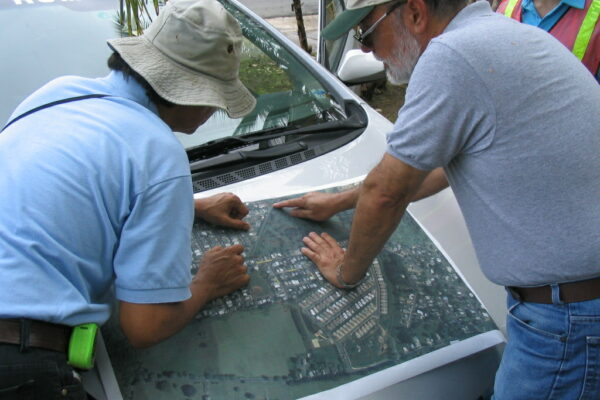Over the years, the projects conducted by the Puerto Rico Water Resources and Environmental Research Institute have played a significant role in benefiting the Puerto Rican community. Through innovative research and practical solutions, these initiatives have addressed critical water quality issues, improved environmental sustainability, and contributed to the protection of public health.
Our Impact

Our Projects
Results from this project will allow USDA-NRCS to provide accurate recommendations to farmers on size and capacity of vegetated drainage channels and waterways. Design of hydrologic/hydraulic modifications in farms and rural areas will be improved.
This project aims to establish a database for detecting and quantifying atrazine and glyphosate in water streams near agricultural sites in the Western region of Puerto Rico. It also seeks to develop a reliable monitoring protocol to raise awareness about water quality impacts among farmers, the scientific community, and regulatory agencies.
The investigation considers how the buoyant force is affected in direction and magnitude due to the water flow on steep slopes. Based on the results of the investigation, the effects of the buoyant force in the longitudinal slope was evaluated.
The main goal of this research was to provide a flood regionalization study for Puerto Rico based on recent advances in watershed classification and parameter estimation techniques. The regional flood frequency was achieved using the “index-flood” procedure in combination with the regional L-moment algorithm.
The purpose of this research was to evaluate the potential of the CCAs as ADC materials achieving resource recovery, enhancing biological decomposition, and subsequently inducing early settlement of landfills.
This study develops a Water Quality Index (WQI) for Puerto Rican rivers, scoring water quality on a scale of 0 to 100 based on evaluated constituents, classifying it as good, moderate, average, alert, or poor.
This research selected sediment transport functions for two watersheds in Saint Thomas, V.I., using a methodology which does not require long periods of sediment discharge measurements. Instead, it used grain size distributions, geometric and hydraulic parameters of the water course to identify those sediment transport functions more appropriate for the existing conditions.
The main objective of this work is to provide a procedure to identify fecal coliform bacterial contamination sources within specific regions employing Geographical I Information Systems (GIS) technology. The work presented is one of the first efforts in the stage of problem identification from bacterial sources.
The research aimed to integrate the sediment transport functions of Yang and Ackers-White into Bhallamudi and Chaudhry’s algorithm to develop a sediment transport model for simulating bed aggradation and degradation in alluvial channels. The model was validated using experimental data from Soni et al. (1980) for sediment overload-induced aggradation and Begin et al. (1981) for bed degradation due to downstream elevation drop.
The project aims to investigate the use of waste tire crumb rubber to remove inorganic contaminants (such as arsenic and mercury) and polycyclic aromatic hydrocarbons (PAHs) from aqueous solutions.
This proposal focuses on evaluating crumb rubber as a low-cost, scalable material for removing inorganic, organic solvents, and antimicrobials from aqueous effluents. The project aims to optimize its sorption capacity and investigate conditions for desorption, with the goal of applying this technology to treat polluted water and remediate contaminated soils.
The benefits of this study were that it allowed to obtain new scientific information related to pesticide and other toxic organic and inorganic residues in groundwater from JBNERR, Las Mareas and Aguirre Forest Urban, industrial and agricultural developments are expected to increase in this zone.
This project presents a mathematical model for the biodegradation of volatile organic compounds (VOCs) in a SBR including volatilization losses and competitive inhibition kinetics. The model is applied in the simulation of a SBR treating a mixture of two different substrates.
The main objective of this research was to do a comparative study of the water surface levels obtained with one and two dimensional hydraulic models. The study modeled the flood plain with different aperture angles, meanders with different sinuosity and flood plain to meander amplitude ratio for steady and unsteady flow conditions.
The general goal of the project is to investigate the sorption behavior of crumb rubber for removing inorganic and organic contaminants from aqueous solutions, aiming to develop a low-cost and scalable technology for water treatment and pollution remediation.
The main objective of this work is to provide a protocol for the application of a management tool for the development and assessment of strategies for the control, reduction, and management of non-point pollution sources in Puerto Rico. The work presented is one of the first efforts of the application of U.S. EPA’s BASINS to Puerto Rico.
The objective of the research is to create a hydrological model of the Cafñas River subbasin located in Añasco, Puerto Rico using the program BASINS (Better Assessment Science Integrating Point and Nonpoint Sources) with an interface to the HSPF (Hydrological Simulation Program-Fortran).
One goal of the Region 2 Project is to enhance the communication among the land grant universities to better support local, state and regional initiatives for improving water quality
The goal of this project was to establish an innovative wastewater treatment demonstration system in the Gurabo Experiment Station of the University of Puerto Rico. The system will consist of a septic tank, dosing tank with pump and an above ground infiltration field using sand as a filtering media.
This proposal evaluates the removal of heavy metals from the thickener tank effluent at the Miradero Water Treatment Plant in Mayagüez, focusing on how different polymers could be incorporated into the existing treatment process to meet discharge permit requirements for heavy metals.
The purpose of this study is to determine the safe yield of specific lakes and the associated tunnel system by analyzing historical flow data or, in the absence of such data, using stochastic hydrology techniques to generate synthetic flow time series. This ensures a reliable and representative analysis that accurately reflects the conditions and characteristics of the study area.
